My Lab
 Prof. Yun Suk Huh
Prof. Yun Suk Huh
Professor, Department of Biological Engineering
Director, NanoBio High-Tech Materials Research Center
Inha University, Incheon, Korea 402-751
Editor-in-Chief: Carbon Letters
Associate Editor: BioChip Journal
Webpage: http://nbalab.inha.ac.kr/
Dear AFOB members,
I would like to first thank Prof. Yoon-Mo Koo, Editor-in-Chief of AFOB Newsletter, to give me this opportunity to introduce my lab and research to all AFOB members. I received my engineering B.S. & M.S. degrees from the College of Engineering, Chungnam National University, Korea (2000, 2003). I received my Ph.D. from Korea Advanced Institute of Science and Technology (KAIST) in Chemical engineering in August 2007. I was working with micro separation technology of protein for application of micro total analysis system (micro-TAS) under the guidance of Prof. Won Hi Hong. My PhD works included Bio-micro-electro-mechanical-systems (Bio-MEMS) experiment for the application in micro-TAS for the diagnosis of tumor.
I also carried out postdoctoral research in David Erickson’s lab at Cornell University (2007-2010), focusing on the fabrication of opto-fluidic device for biomolecules detection. After spending 3 years as a senior researcher at Korea Basic Science Institute (KBSI), I have become a professor at Inha University since 2013. The main research interest of his laboratory is to develop i) the optical and electrochemical sensor for the highly sensitive detection of biomolecules and diseases. In addition, he is working on the synthesis of ii) biofunctional materials for drug delivery and therapy. My research work required the techniques of detection of biomolecules such as protein, DNA, chiral compounds, and organic acids, functionalization of organic/inorganic hybrid materials. I have published more than 350 research articles in SCI journals.

1. Discovery of Functional Natural Compound and Application as Drug Delivery System
Drug delivery system is a technology that effectively delivers a specific drug to a desired body part or controls the release of the drug as desired to minimize side effects and increase efficacy of existing drugs. Existing drugs are difficult to act only in the desired area, so the concentration of the drug increases, and there is a problem that side effects occur due to the action in the unwanted area or time. However, the drug delivery system allows the drug to be effectively delivered to the target site, so a relatively small amount of drug can be effective. Our lab is attempting various methods to make the existing drug delivery system more effectively. A paper that increased the anticancer effect by applying two drugs to one nanoparticle and enabling combinational therapy was published in Mater. Sci. Eng. C. In addition, our lab is currently developing a drug delivery system with strategies such as lysosomal escape nanoparticle, biodegradable nanoparticle, drug release control, and tumor microenvironment responsive nanoparticle.

Introduction of drug delivery system.
2. Generation of Biosensors and Bioremediation
● Detection of Melamine, Histamine and Ractopamine through LFIA and LSPR Technique
Lateral flow immunoassay (LFIA) is a technique that is well known as a pregnancy diagnostic device or a COVID-19 rapid diagnostic kit and is simple to use and intuitive to detect quickly without professionals or precision devices. It is a device that can detect target substances through antigen-antibody reactions by dropping the sample solution into the LFA kit and withing about 10 minutes. Depending on the targets (melamine, histamine or ractopamine), our lab is conducting research to detect very low concentration of targets that may exist in blood or food using sandwich assay or composite assay. Localized surface plasmon resonance (LSPR) is a technology based on the peculiar optical properties of metal nanoparticles such as gold and silver by light, and is widely studied in spectral sensors, biosensors and fluorescence sensors. LSPR is determined by the size, shape, type of metal, and environment of metal nanostructure. In addition, since LSPR is very affected by changes in the surrounding environment, many studies are being conducted to utilize these sensitive reaction characteristics and apply them to the sensing field. Our lab has been conducting research to detect various target materials by manufacturing LSPR chips coated with gold nanoparticles, and in particular, it has greatly expanded its versatility by making them available for universal cuvettes.

Basic theory of lateral flow immunoassay (LFIA; top) and localized surface plasmon resonance
(LSPR; bottom).
● Target-specific Antibody Research through Phage Display Technique
Phage display is a method for screening peptides which is specifically binding on the target molecule. First, we immobilize target material on the plate. After the fixation, M-13 phage library will bound on target material. Then the phage which has a binding affinity with target material adheres to the surface. Washing out the unbound phages, we can earn target specific phages. This step is called biopanning. Repeating the biopanning more than two or three times, we can get peptides more specifically binding on targets. After the biopanning, our lab checked the binding affinity of peptide through ELISA. Finally, target specific binding peptides will be applied on receptor of biosensors.
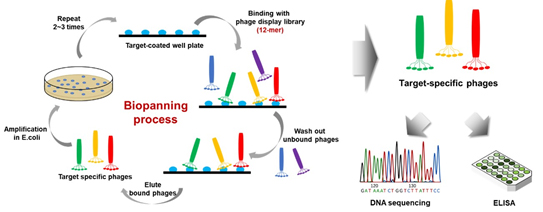
Schematic illustration of phage display technique procedure.
● Detection of free amino acids through electrochemical sensors
Free amino acids (FAA) have different electrochemical signals for each types of amino acids. Therefore, in order to measure the content of FAA, the electrochemical signal of free FAA must be made constant. In our lab, L-amino acid oxide (LAAO) was used, and LAAO decomposes all amino acids except proline to produce H2O2. Since FAA is decomposed by the amount generated by H2O2, the amount of H2O2 can measure the content of FAA. The final goal is to develop free amino acid sensors as contactless electrochemical sensor.
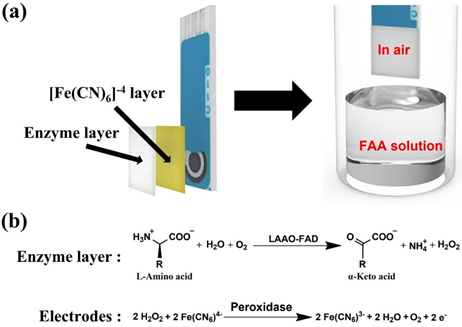
(a) Concept image of electrochemical sensor to detect free amino acid content, and (b) two main chemical reactions occurring in the electrochemical sensor.
3. Generation of Functional Materials for Biological and Environmental Application
● Fabrication of multi-functional adsorbents
Our lab designed and synthesized a core-shell multi-functional alginate-based adsorbent and investigated the simultaneous adsorption of radioactive isotopes and chemical dyes. Tri-functional core containing Prussian blue, hydroxyapatite, and MXene, which can effectively adsorb Cs+, Sr2+ and rhodamine B, were synthesized using a tetrapod needle injector, which can spatially encapsulate three different compounds within a single alginate hydrogel particle. Our lab also demonstrated a centrifuge-based micronozzle system to generate multi-functional Prussian blue and hydroxyapatite-embedded alginate adsorbents for simultaneous adsorption of cesium and strontium. Specifically, micro-adsorbents have two different compositions at their opposite sides which show advanced chemical functionalities such as Cs+ and Sr2+ adsorption simultaneously.
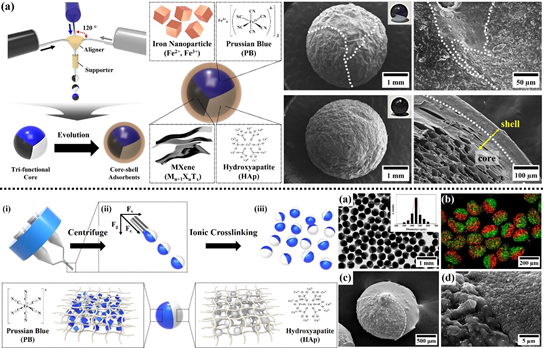
Fabrication of multi-functional adsorbents through tetrapod needle injectors (top) and centrifuge-based micronozzle system (bottom).
● Functional bionanomaterials design and cancer cell treatment model research based on microplasma droplet platform
In order to expand the limited utilization range of bulk plasma systems driven under existing atmospheric conditions, a closed microfluidic reactor was designed and manufactured, and an active radical generation mechanism was identified, and a microfluidic control technology was developed. The microfluidic droplet reactor and plasma driving system were integrated, and drug delivery functional material synthesis and complex inorganic metal optical imaging material were synthesized using a controlled plasma active solution. It is identified to develop an efficient three-dimensional cell encapsulation technology that can precisely control plasma treatment within microfluidic channels.
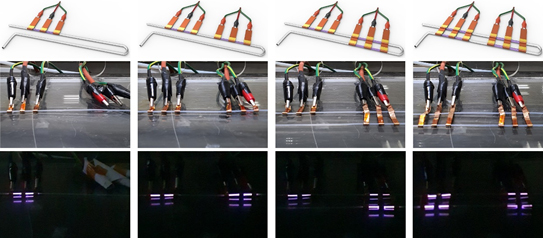
Generation of microfluidic system-integrated microplasma droplet platform and variation of number of channels.
● Synthesis of MOF-chitosan combined adsorbent for tritium adsorption
Our lab is introducing the research for successful removal of tritium from aqueous solution through metal organic framework (MOF)-chitosan combined adsorbents. Various literature survey and successful material synthesis were conducted through simple droplet through needle injectors. Our lab is conducting research by both dividing the synthesized materials into batch experiments and column experiments.
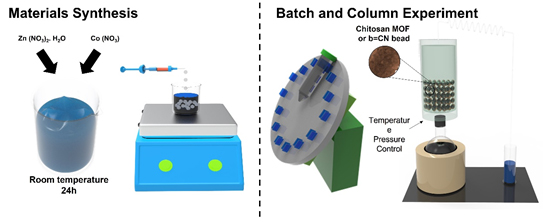
Schematic diagrams of MOF-chitosan combined adsorbent synthesis (left) and research approach of tritium adsorption through batch and column experiments (right).
Acknowledgement
I would like to acknowledge the long-term support of Basic Science Research Program through National Research Foundation of Korea Republic. My special thanks go to all graduate students and research professors who work eagerly participate on challenging projects.
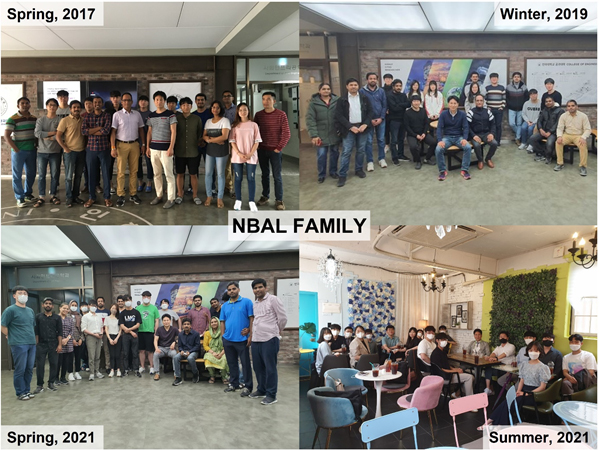
● Selected papers (2019-2021) * Corresponding author IF: 2019 Impact factor
1. Reddicherla Umapathi, Sonam Sonwal, Min Ji Lee, Gokana Mohana Rani, Eun-Seon Lee, Tae-Joon Jeon, Sung-Min Kang, Mi-Hwa Oh, Yun Suk Huh* "Colorimetric based on-site sensing strategies for the rapid detection of pesticides in agricultural foods: New horizons, perspectives, and challenges", Coordination Chemistry Reviews, 446, (2021) 214061 (IF 22.315).
2. Nilesh R. Chodankar, Pragati A. Shinde, Swati J. Patil, Seung-Kyu Hwang, Ganji Seeta Rama Raju, Kugalur Shanmugam Ranjith, Deepak P. Dubal, Yun Suk Huh*, Young-Kyu Han* "Solution-free self-assembled growth of ordered tricopper phosphide for efficient and stable hybrid supercapacitor", Energy Storage Materials, 39, (2021) 194-202 (IF 16.280).
3. Sapna Sedha, Hoomin Lee, Siddhartha Singh, Sunil Kumar, Subodh Jain, Ajaz Ahmad, Yousef A. Bin Jardan, Sonam Sonwal, Shruti Shukla, Jesus Simal-Gandara, Jianbo Xiao, Yun Suk Huh*, Young-Kyu Han*, Vivek K. Bajpai* "Reproductive toxic potential of phthalate compounds – State of art review", Pharmacological Research, 167, (2021) 105536 (IF 7.658).
4. Eluri Pavitra, Begum Dariya, Gowru Srivani, Sung Min Kang, Afroz Alam, Putty-Reddy Sudhir, Mohammad Amjad Kamal, Ganji Seeta Rama Raju, Young-Kyu Han, Bhaskar Venkata Kameswara Subrahmanya Lakkakula, Ganji Purnachandra Nagaraju, Yun Suk Huh*, "Engineered nanoparticles for imaging and drug delivery in colorectal cancer", Seminars in Cancer Biology, 69, (2021) 293-306 (IF 15.707).
5. A.T. Ezhil Vilian, Reddicherla Umapathi, Seung-Kyu Hwang, Yun Suk Huh*, Young-Kyu Han*, "Pd–Cu nanospheres supported on Mo2C for the electrochemical sensing of nitrites", Journal of Hazardous Materials (2020), 408, 124914 (IF 10.588).
6. Vivek K. Bajpai¹, Imran Khan, Shruti Shukla, Sung-Min Kang, Faisal Aziz, Kumud Malika Tripathi, Deepika Saini, Hye-Jin Cho, Nam Su Heo, Sumit K. Sonkar*, Lei Chen*, Yun Suk Huh*, Young-Kyu Han*, "Multifunctional N-P-doped carbon dots for regulation of apoptosis and autophagy in B16F10 melanoma cancer cells and in vitro imaging applications", Theranostics (2020), 10(17), 7841-7856 (IF 11.556).
7. Sung-Min Kang, Bumjun Park, Ganji Seeta Rama Raju, Seungmin Baek, Sk. Khaja Hussain, Cheol Hwan Kwak, Young-Kyu Han, Jae Su Yu*, Sang-Wook Kim*, Yun Suk Huh*, "Generation of Cesium Lead Halide Perovskite Nanocrystals via a Serially-Integrated Microreactor System: Sequential Anion Exchange Reaction", Chemical Engineering Journal (2020), 384, 123316 (IF 13.273).
8. Muruganantham Rethinasabapathy, Jeong Han Lee, Kwang Chul Roh, Sung-Min Kang, Seo Yeong Oh, Bumjun Park, Go-Woon Lee, Young Lok Cha, Yun Suk Huh*, "Silver Grass-derived Activated Carbon with Coexisting Micro-, Meso- and Macropores as Excellent Bioanodes for Microbial Colonization and Power Generation in Sustainable Microbial Fuel Cells", Bioresource Technology (2020), 300, 122646 (IF 9.642).
9. Nilesh Rajaram Chodankar, Ganji Seeta Rama Raju, Bumjun Park, Pragati Shinde, Seong Chan Jun, Deepak P. Dubal*, Yun Suk Huh*, Young-Kyu Han*, "Potentiodynamic Polarization Assisted Phosphorous-containing Amorphous Trimetal Hydroxide Nanofiber for Highly Efficient Hybrid Supercapacitors", Journal of Materials Chemistry A (2020), 8, 5721-5733 (IF 12.732).
10. A.T. Ezhil Vilian, Wonyoung Kim, Bumjun Park, Seo Yeong Oh, TaeYoung Kim, Yun Suk Huh*, Chang Kwon Hwangbo, Young-Kyu Han, "Efficient electron-mediated electrochemical biosensor of gold wire for the rapid detection of C-reactive protein: A predictive strategy for heart failure", Biosensors and Bioelectronics (2019), 142, 111549 (IF 10.618).
11. Eluri Pavitra, Ganji Seeta Rama Raju, Seyed Majid Ghoreishian, L. Krishna Bharat, Sreekantha Reddy Dugasani, Jin Young Park, Sung Ha Park, Jae Su Yu, Young-Kyu Han, Yun Suk Huh*, "Streptavidin activated hydroxyl radicals enhanced photocatalytic and photoelectrochemical properties of membrane-bound like CaMoO4:Eu3+ hybrid structures", Journal of Materials Chemistry A, 7, 23105-23120 (IF 12.732).
12. Ilsong Lee, Sung-Min Kang, Sung-Chan Jang, Go-Woon Lee, Ha Eun Shim, Muruganantham Rethinasabapathy, Changhyun Noh, Yun Suk Huh*, "One-Pot Gamma Ray-Induced Green Synthesis of a Prussian Blue-Laden Polyvinylpyrrolidone/Reduced Graphene Oxide Aerogel for the Removal of Hazardous Pollutants", Journal of Materials Chemistry A (2019), 7, 1737-1748 (IF 12.732).


